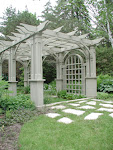Now, before you are too rough on this structure, this is part of what was one of the most beautiful yards in Collingwood Ontario Canada for a couple of decades. This was simply cutting edge work considering that it was more than 50 years ago that it was built.To be honest, it has striking similarities to some of my designs and when I finally had opportunity to see his work up close I was shocked.
This pergola was built by a carpenter named Doug Abernathy in the late 50's early 60's and by the looks of some of the detailing, his father helped with some of the joinery. I've broken this into 2 posts so that you can get a close look at both structures.
I drove by this place quite a bit, and even stopped in and met Doug while he was having a garage sale about a decade ago. He was a gregarious man, and when I was admiring his handy-work he started telling me about his father, his grandfather and his great grandfather that were all home builders. He was most proud that he still had the gingerbread templates his dad had created, and he knew how it could be done today. He tried to convince me it was a craft that I should carry on--alas, I had another path in mind.
Driving by this house (and the picket fence that disappeared about 8 years ago), noticing the second structure (that I will look at in the next post), I had gained some serious respect for his proportions and how the look just worked together. It was unique detailing I hadn't seen anywhere else, so I was sure that he was a designer, not a copycat.
Young men rush here...and there, and always have 3 things to do and never bother to spend time with the people that they should, so, I simply never spoke to Doug again. He's in a home now, but this spring I saw a worker there doing carpentry in the house, so I dropped in. Here is a bit of what I saw.
Above, you will notice a curved brace which makes the structure stable and it is about 3" wide. I couldn't tell whether it was a cut curve, or a lamination, but for it's age, it has stood up well. There are subtle cracks, but that could just be expansion and contraction. It might be a glued up lamination with the end cuts sealed with pine tar, (which was evident on the other structure).
He did curved benches, made for comfort and it is all solid wood--not plywood. He left the slats more spaced than you would expect, and that is likely why it has aged gracefully. This was something I hadn't seen or expected as I drove by--and I hadn't gotten close enough to see these structures back when I met Doug. On the right hand side there is a potting bench--however I think that was retrofitted after.
Here is a serious testament to ability. A gate that still works after 50 years. It is braced, it is built stronger than it needed to be, and the joinery has remained tight because he sealed it somehow as it was built. The trelliswork has held together and lasted because it was lapped over--not notched into itself.
This garden structure was made long before anyone in North America used the word "Pergola". For this reason, I would nominate Doug Abernathy as one of the people that brought Pergolas into the modern age. If I had had a closer look at his structures early on, I wouldn't have had nearly as much to learn about them in my first 25 years in the business.
by Lawrence Winterburn














